“There is no justice in the world,” one young girl wrote in her diary, struggling through starvation and imprisonment under Nazi rule, “not to mention in the ghetto.”
Life in the Jewish ghettos of the Holocaust was indeed torture. After their invasion of Poland in 1939, the Nazis began setting up Jewish ghettos both in that country and across Europe. Jewish civilians were branded and forcibly deported into small, cramped quarters, often segregated from the rest of the city with walls or barbed wire. There they waited, hoped, and prayed, most unaware that this was nothing more than the first step in the Nazi plot for the systematic eradication of Europe's Jewish population.
Before they could even be sent to concentration camps, however, many prisoners of the Jewish ghettos were starved out. They were given little to nothing to eat, leaving them to suffer through painful fits of hunger. Some died of starvation, and many more from the diseases that were allowed to spread wildly inside of the ghetto walls.
And there was little anyone could do to stop it. The people on the other side of the walls were strictly forbidden from smuggling food into the Jewish ghettos — on penalty of death.
Still, most ghetto dwellers just did their best to survive. They had little idea what horrors the Nazis were preparing them for, and many could only resolve themselves to struggle through the hard times and pray the Nazis would lose the war and someone would come and liberate them.
That freedom, though, came too late. By 1942, the Nazis had begun the next phase of their plan: systemically exterminating every person inside those ghetto walls. Some ghettos, especially in the USSR, were simply turned into "extermination ghettos," where the people would be dragged out into the wounds and shot. In other ghettos, the people would be sent off to death camps like Auschwitz to be gassed and incinerated.
When the people in the Jewish ghettos began to realize that death was imminent, some started fighting back. There were uprisings in ghettos across the continent, with Jewish resistance fighters grabbing anything they could find and desperately trying to fend off the Nazis that had stolen their homes. The most famous revolt was the Warsaw ghetto uprising, where Jews and Poles worked together to try to stop the SS from dragging their families off to the death camps.
As hard as they fought, though, a few resistance fighters couldn’t hold off the Nazi war machine forever. The SS simply struck back harder. Much of the Warsaw ghetto was burned to the ground, the people were dragged out of hiding, and the men and women were rounded up and sent to Treblinka, one of The Holocaust’s most brutal death camps.
In time, however, liberation finally came. In late 1944 into 1945, the Allied armies marched through Europe, fighting off the Nazi forces and freeing the people who had suffered through it all. For millions, though, help came too late.
Millions of prisoners of the Jewish ghettos died at the hands of the Nazis — but the photos survive; a warning, showing us what life looks like at the start of a genocide.
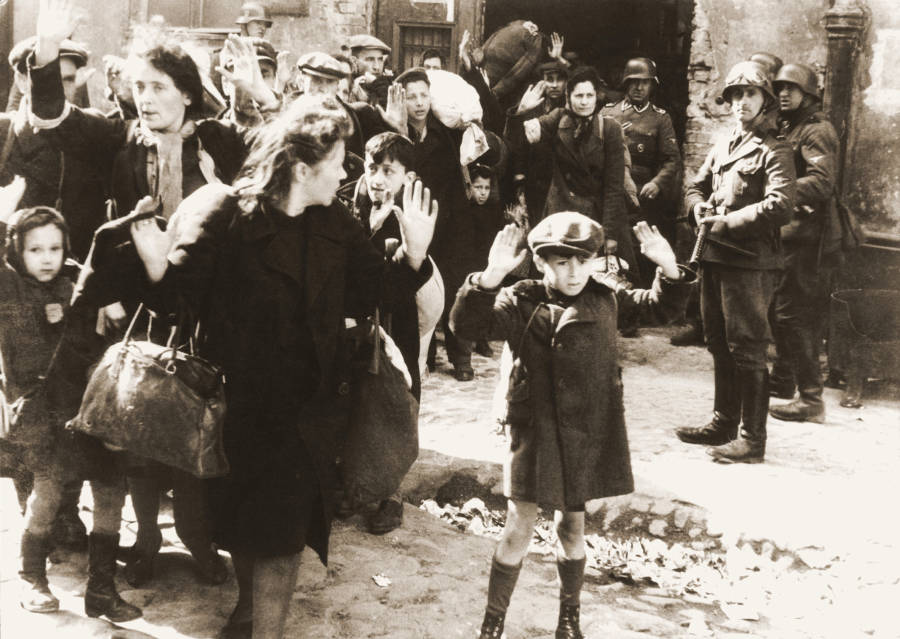
Polish Jews are forced out of hiding by the Nazis during the Warsaw ghetto uprising.
Warsaw, Poland. May 1943.
Wikimedia Commons

Very young Ukrainian nationalists, in cooperation with the Nazi SS and armed with clubs, chase a Jewish woman through the streets of the Lviv ghetto, where at least 6,000 Jews were killed by militias and Nazi forces.
Lviv, Poland. 1941.

Starving children huddle for warmth inside the Warsaw ghetto.
Warsaw, Poland. Circa 1940-1943.
Wikimedia Commons

Warsaw, Poland. Circa 1940-1943.
Wikimedia Commons

Jewish children climb up to sneak a peek of what's happening on the other side of the ghetto wall.
Warsaw, Poland. Circa 1941.
Wikimedia Commons
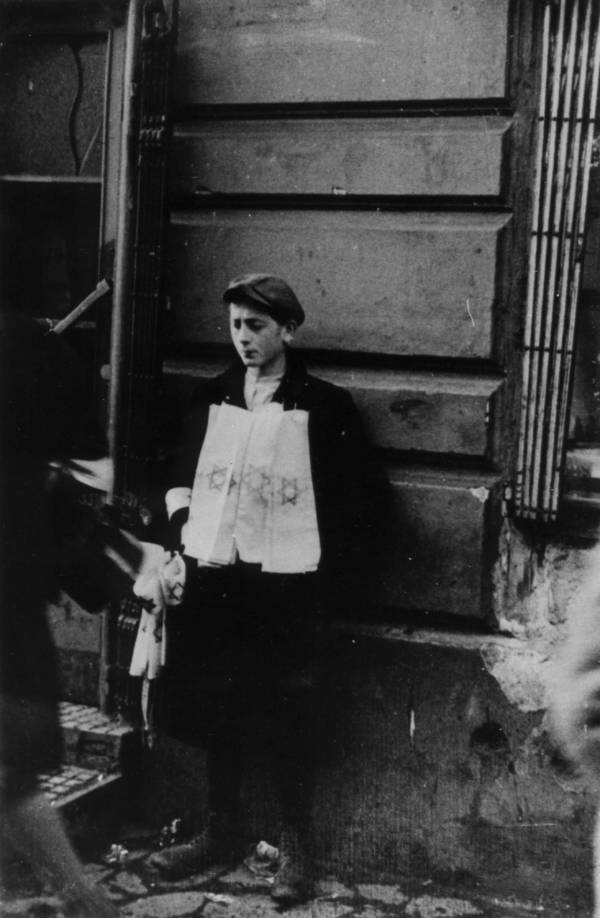
A boy holds up a sign labelling him as a Jew.
Warsaw, Poland. Circa 1940-1941.
Wikimedia Commons

A dead man lies in the street, surrounded by a crowd of people, in the Warsaw ghetto.Warsaw, Poland. Circa 1940.
Imagno/Getty Images

A boy sits in the street in the Warsaw ghetto.
Warsaw, Poland. February 1941.
Joe J. Heydecker/Galerie Bilderwelt/Getty Images

Wikimedia Commons

A boy holds up a sign labelling him as a Jew.
Warsaw, Poland. Circa 1940-1941.
Wikimedia Commons

A dead man lies in the street, surrounded by a crowd of people, in the Warsaw ghetto.Warsaw, Poland. Circa 1940.
Imagno/Getty Images

A boy sits in the street in the Warsaw ghetto.
Warsaw, Poland. February 1941.
Joe J. Heydecker/Galerie Bilderwelt/Getty Images

Jewish Resistance fighters, trying to keep their families from being deported to the death camps, are caught by the SS. In the original caption, the SS labelled them "bandits" for trying to avoid the death camps.
Warsaw, Poland. April or May 1943.
Wikimedia Commons

Jews are lined up against the ghetto wall to be searched. Warsaw, Poland. April or May 1943.
Wikimedia Commons
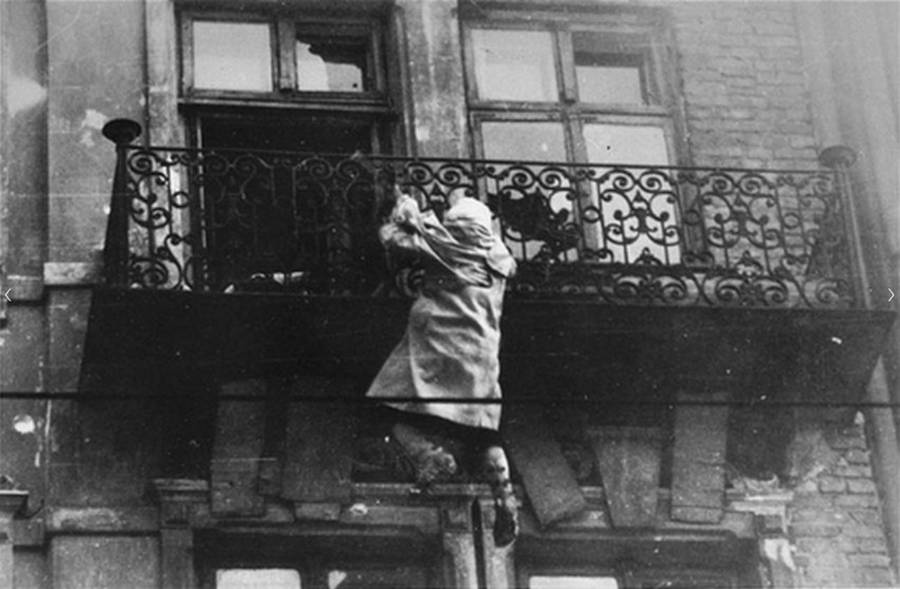 A woman dangles from a balcony of a burning building during the Warsaw ghetto uprising, desperately trying to escape with her life.
A woman dangles from a balcony of a burning building during the Warsaw ghetto uprising, desperately trying to escape with her life.
Warsaw, Poland. April or May 1943.
Wikimedia Commons

A Jewish man crawls out of his hiding place in the floor. Warsaw, Poland. April or May 1943.
Wikimedia Commons

Warsaw, Poland. April or May 1943.
Wikimedia Commons

Jews are lined up against the ghetto wall to be searched. Warsaw, Poland. April or May 1943.
Wikimedia Commons
 A woman dangles from a balcony of a burning building during the Warsaw ghetto uprising, desperately trying to escape with her life.
A woman dangles from a balcony of a burning building during the Warsaw ghetto uprising, desperately trying to escape with her life. Warsaw, Poland. April or May 1943.
Wikimedia Commons

A Jewish man crawls out of his hiding place in the floor. Warsaw, Poland. April or May 1943.
Wikimedia Commons

A Jewish man is forced out of hiding during the Warsaw ghetto uprising.
Warsaw, Poland. April or May 1943.
Wikimedia Commons

An emaciated corpse, likely dead from hunger, is collected off the streets. Warsaw, Poland. Circa 1941-1942.
Wikimedia Commons
 A housing block burns during the suppression of the Warsaw ghetto uprising.
A housing block burns during the suppression of the Warsaw ghetto uprising.
Warsaw, Poland. April or May 1943.
Wikimedia Commons
Warsaw, Poland. April or May 1943.
Wikimedia Commons

An emaciated corpse, likely dead from hunger, is collected off the streets. Warsaw, Poland. Circa 1941-1942.
Wikimedia Commons
 A housing block burns during the suppression of the Warsaw ghetto uprising.
A housing block burns during the suppression of the Warsaw ghetto uprising. Warsaw, Poland. April or May 1943.
Wikimedia Commons
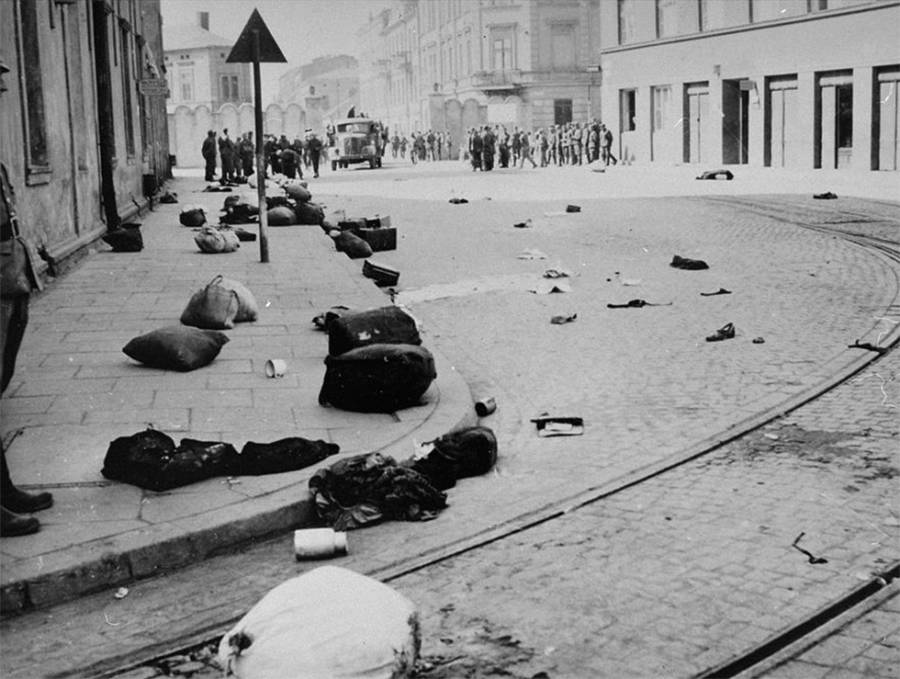 Krakow after the deportation of the Jewish population. Their meager possessions litter the streets.
Krakow after the deportation of the Jewish population. Their meager possessions litter the streets. Krakow, Poland. 1943.
Wikimedia Commons
 The women and children of the Minsk Ghetto walk down the streets, the star of David marking them as Jews.
The women and children of the Minsk Ghetto walk down the streets, the star of David marking them as Jews. Minsk, Belarus. Circa 1941.
Wikimedia Commons
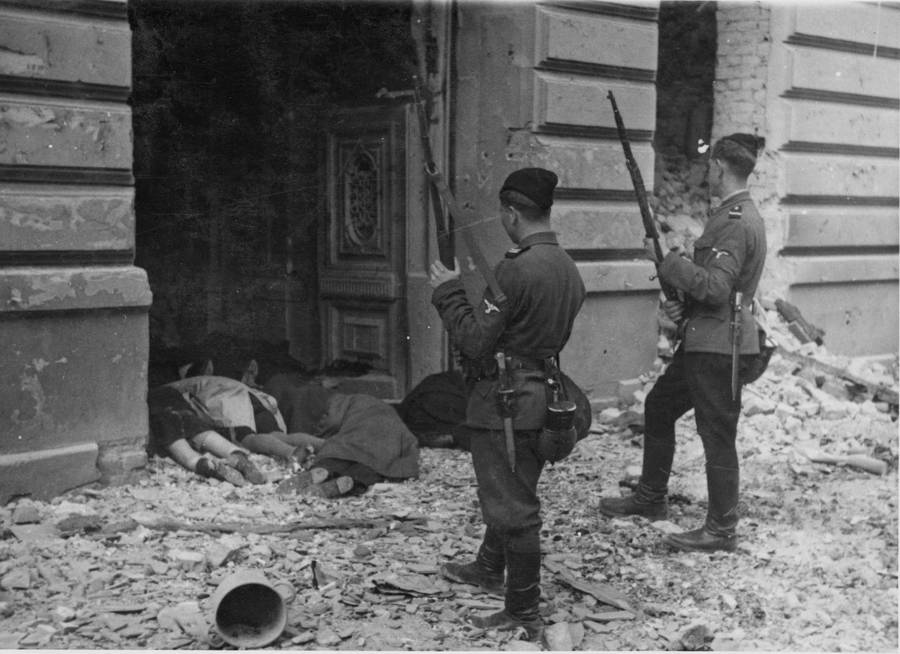
Nazi soldiers stand over the dead bodies of Jewish civilians they have shot dead. Warsaw, Poland. April or May 1943.
Wikimedia Commons
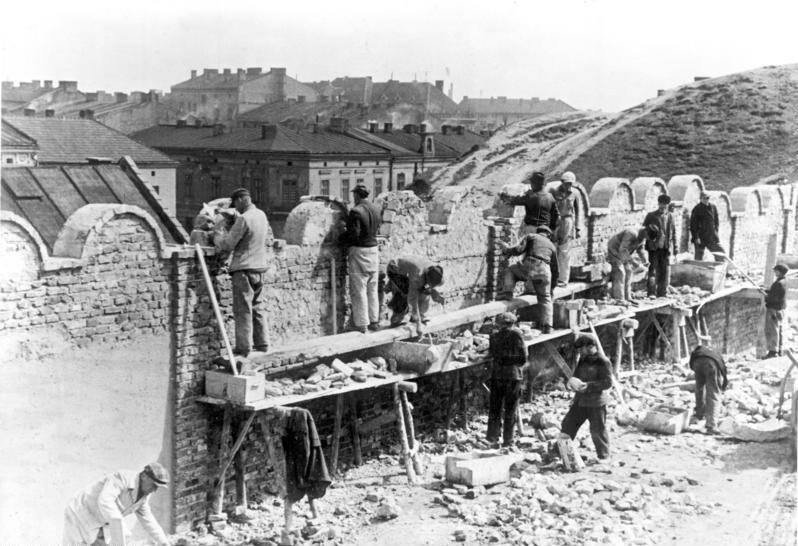
Building the wall to the Krakow ghetto.
Krakow, Poland. May 1941.
Wikimedia Commons
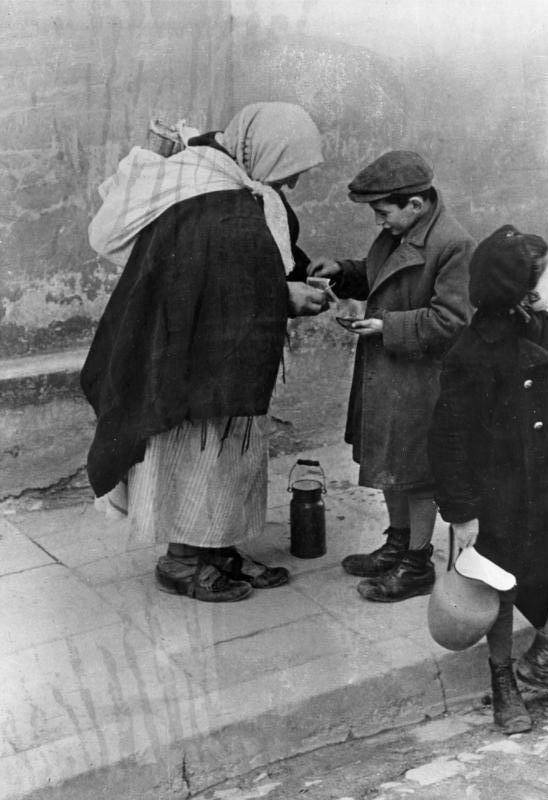
A woman smuggles contraband milk into the ghetto and sells it to a starving child.
Krakow, Poland. May 1941.
Wikimedia Commons
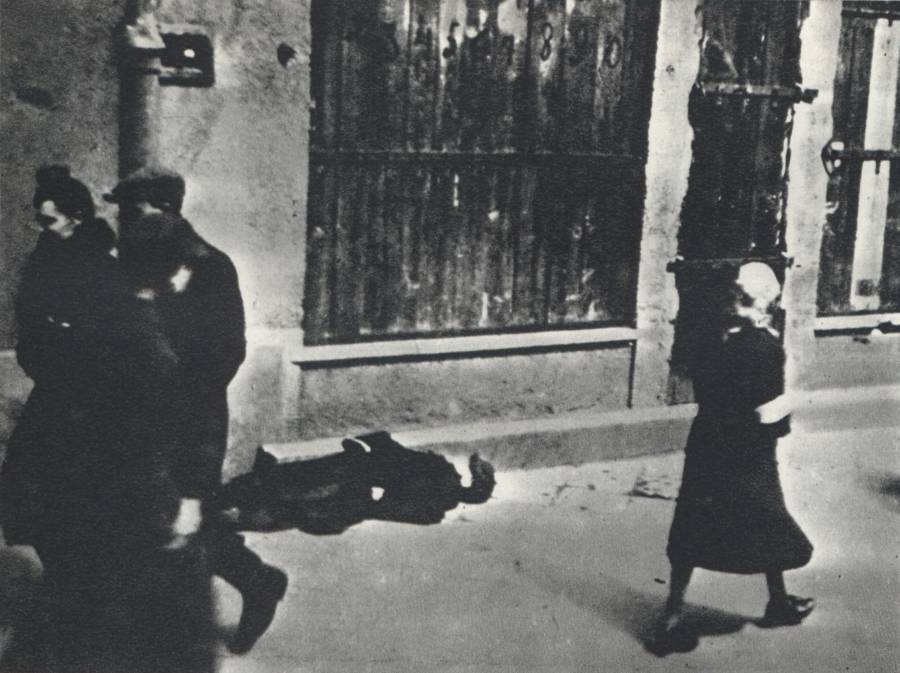
Krakow, Poland. May 1941.
Wikimedia Commons

A dead body lies on the streets of the Warsaw ghetto.
Warsaw, Poland. Circa 1940-1943.
Wikimedia Commons

Warsaw, Poland. Circa 1940-1943.
Wikimedia Commons

An elderly man living inside of a ghetto.
Warsaw, Poland. Circa 1940-1943.
Warsaw, Poland. Circa 1940-1943.
Wikimedia Commons


Carts full of corpses are carried off to the cemetery.
Warsaw, Poland. Circa 1941-1942.
Wikimedia Commons
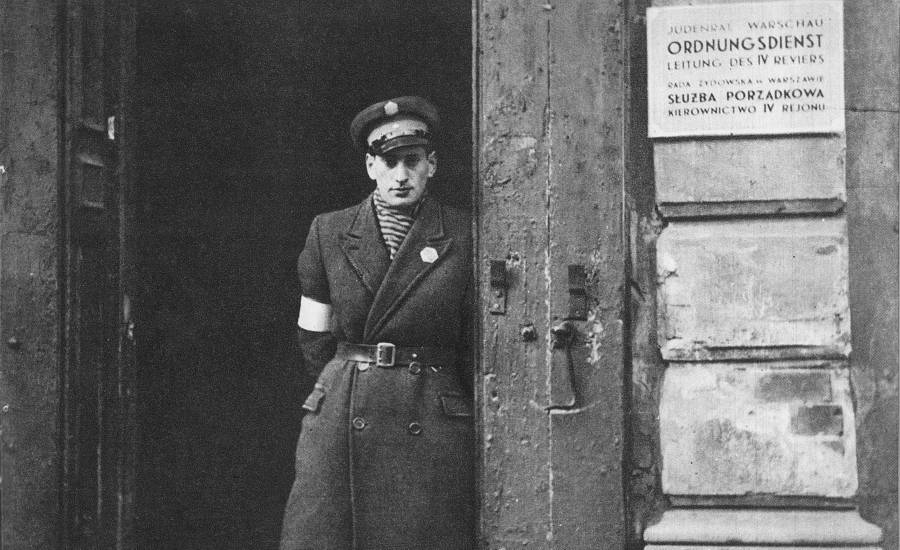
Wikimedia Commons

A Jewish policeman, conscripted by the Nazis to constrict the freedoms of his own people, stands watch by a doorway.
Warsaw, Poland. Circa 1940-1943.
Wikimedia Commons
 Captured Jews are marched off for deportation.
Captured Jews are marched off for deportation.
Warsaw, Poland. April or May 1943.
Wikimedia Commons
 A cart full of clothes rolls through the Warsaw ghetto.
A cart full of clothes rolls through the Warsaw ghetto.
Warsaw, Poland. Circa 1942-1943.
Wikimedia Commons
 Jewish rabbis are rounded up by SS officers.
Jewish rabbis are rounded up by SS officers.
Warsaw, Poland. April or May 1943.
Wikimedia Commons
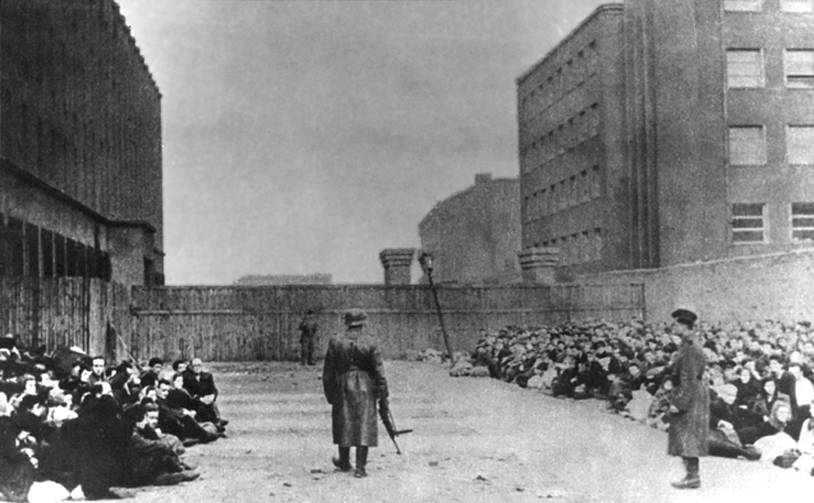
Jews sit and await deportation to the death camps. Warsaw, Poland.
April or May 1943.
Wikimedia Commons
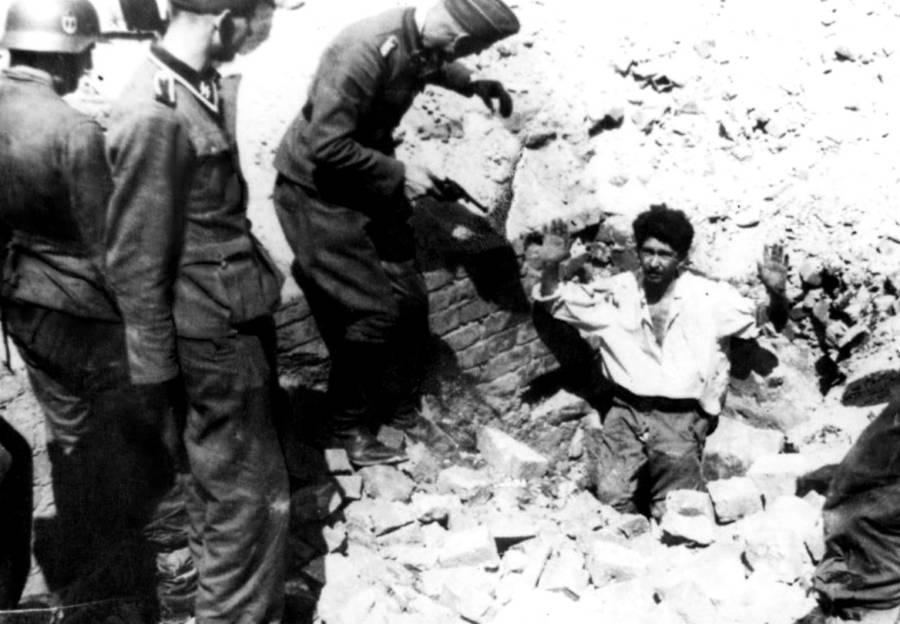
A man comes out of hiding with his hands up.
Warsaw, Poland. April or May 1943.
Wikimedia Commons

The workers of a forced labor factory, where Jewish slaves were forced to make helmets for the Nazis, learn that they will not be spared. Warsaw, Poland. April or May 1943.
Wikimedia Commons
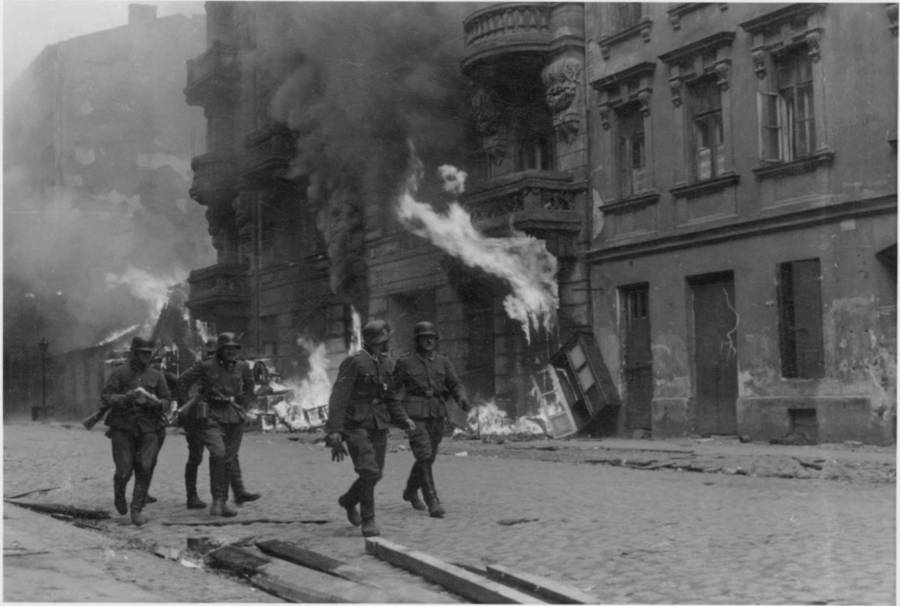
Nazis patrol the burning ghetto of Warsaw.
Warsaw, Poland. April or May 1943.
Wikimedia Commons
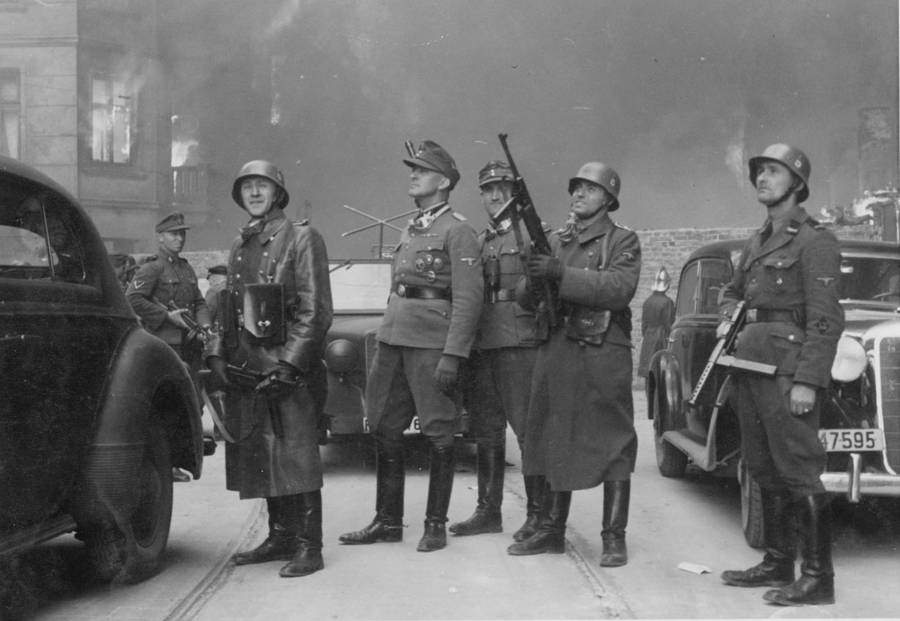
SS Officers enter Warsaw to shut down an uprising.
Warsaw, Poland. April or May 1943.
Wikimedia Commons

Polish families being deported into the Warsaw Ghetto.
Warsaw, Poland. Circa 1940-1942.
Wikimedia Commons

A Polish police officer checks the IDs of two Jewish men. Krakow, Poland.
Circa 1939-1945.
Wikimedia Commons

Jewish laborers work inside a sweatshop. Warsaw, Poland.
Circa 1942-1943.
Wikimedia Commons
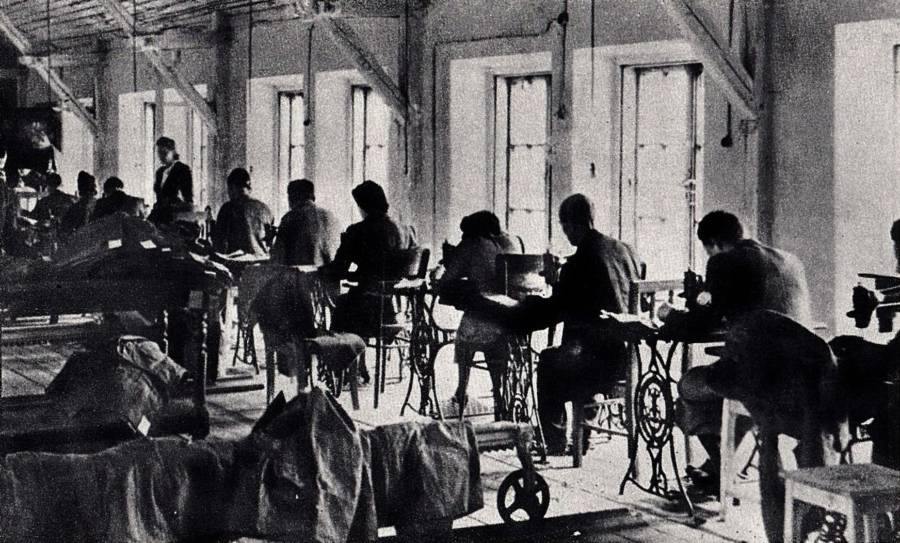
Inside of a sweatshop in a Jewish ghetto. Warsaw, Poland.
Circa 1939-1945.
Wikimedia Commons
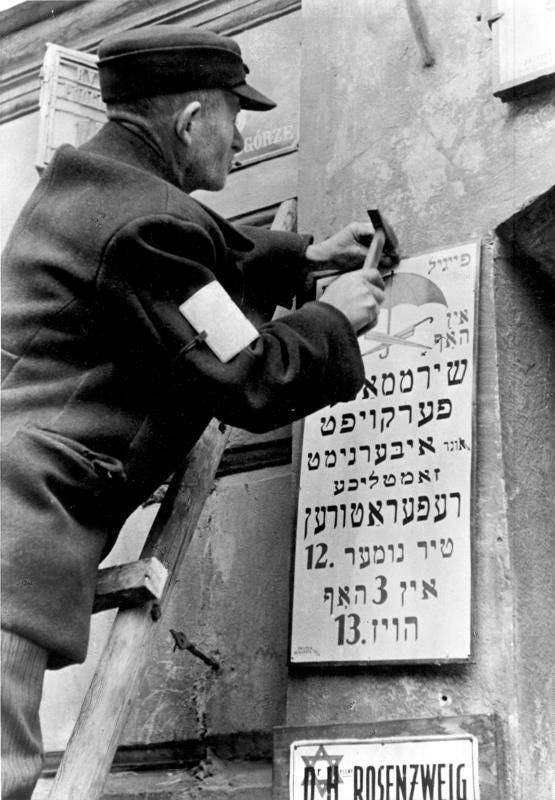
A Jewish doctor replaces his sign, on orders from the Nazis, to one written in Hebrew script and displaying the Star of David.
Krakow, Poland. May 1941.
Wikimedia Commons

A fish stall inside of the Warsaw ghetto, during the early days of the Holocaust. Warsaw, Poland.
May 1941.
Wikimedia Commons
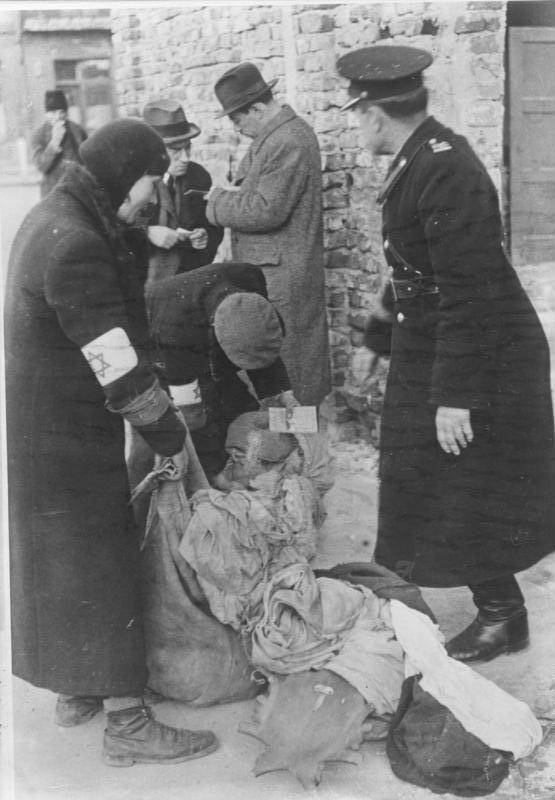
The Nazis crack down on smuggling to keep food from getting into the ghettos. Krakow, Poland. May 1941.
Wikimedia Commons
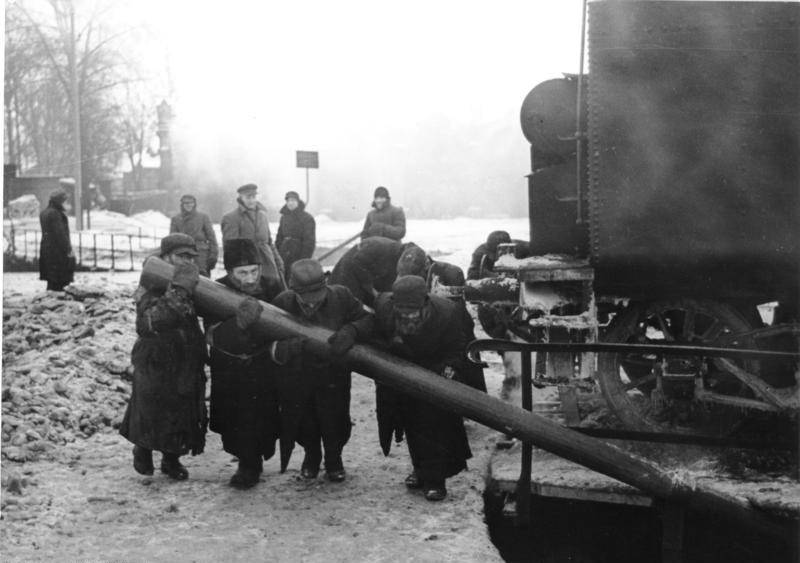
Jews put into forced labor work on the railway.
Minsk, Belarus. February 1942.
Wikimedia Commons
 SS officers interrogate men inside the Warsaw ghetto.
SS officers interrogate men inside the Warsaw ghetto.
Warsaw, Poland. April or May 1943.
Wikimedia Commons
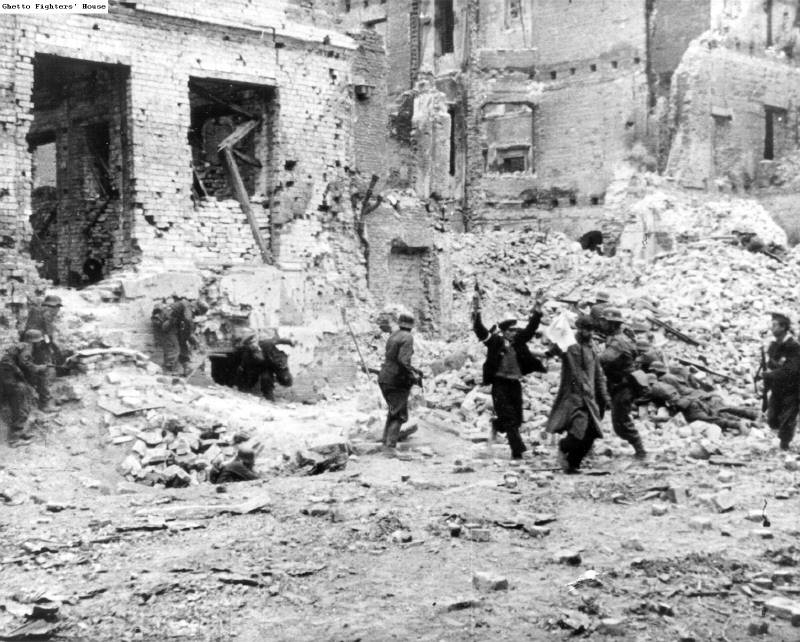
A man is dragged out of hiding as the SS comes in to force the people of the Warsaw ghetto into the death camps.
Warsaw, Poland. April or May 1943.
Wikimedia Commons

Residents of the Warsaw ghetto sit on the curb, awaiting their fate.
Warsaw, Poland. April or May 1943.
Wikimedia Commons

The SS opens the underground bunkers where some have hidden to avoid being dragged out of the ghetto and into the death camps.
Warsaw, Poland. May 1943.
Wikimedia Commons

A family surrenders to the SS. Warsaw, Poland.
April or May 1943.
Wikimedia Commons

An SS lieutenant interrogates a man in the Warsaw ghetto. Warsaw, Poland.
May 1943.
Wikimedia Commons

Nazi soldiers discuss how best to evacuate and deport the Jewish workers inside of a factory.
Warsaw, Poland.
April 1943.
Wikimedia Commons
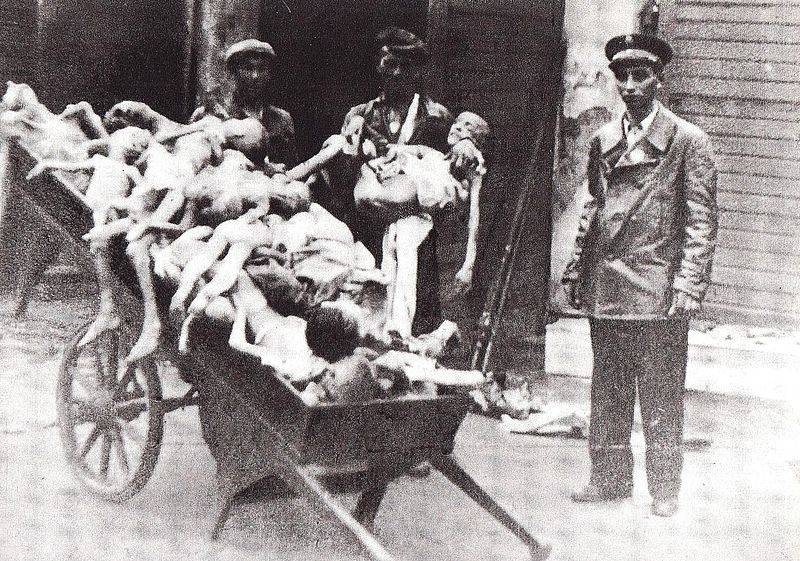
Men carry off a cart filled with the emaciated, starved corpses of children.
Warsaw, Poland. Circa 1941-1942.
Wikimedia Commons
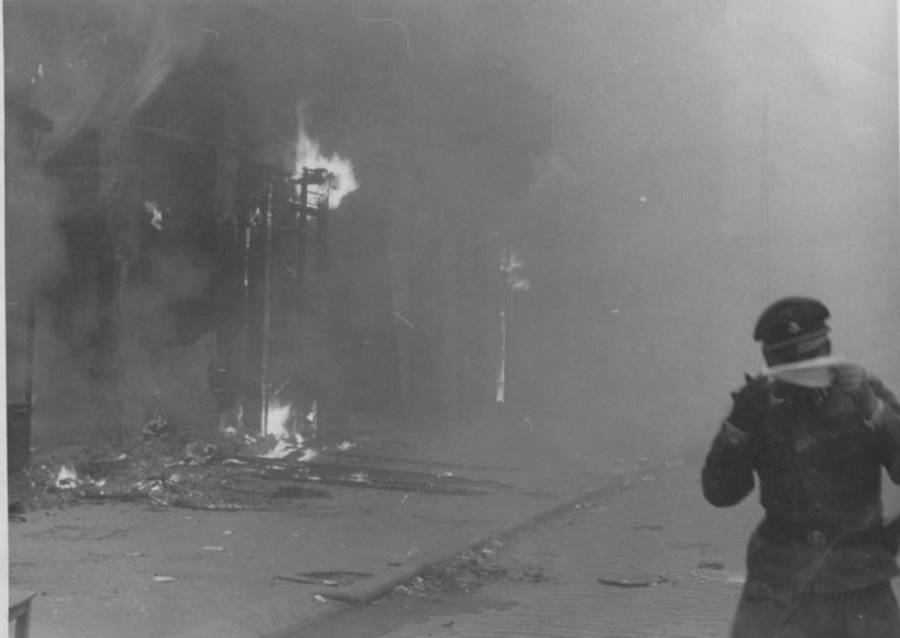
A man covers his mouth with a handkerchief, struggling to breathe through the smoke. Warsaw, Poland. April or May 1943.
Wikimedia Commons

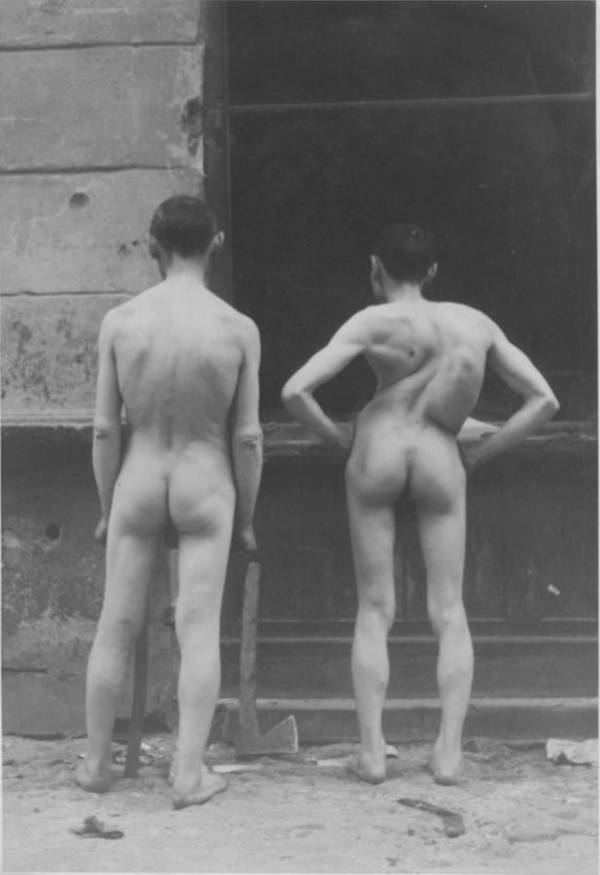 Two men are stripped naked and photographed by Nazi SS soldiers. The Nazi officer who took the photo gave it the title: "The Dregs of Society."
Two men are stripped naked and photographed by Nazi SS soldiers. The Nazi officer who took the photo gave it the title: "The Dregs of Society."
Warsaw, Poland. April or May 1943.
 Nazi officers watch as the Warsaw ghetto burns.
Nazi officers watch as the Warsaw ghetto burns.
Warsaw, Poland. April or May 1943.
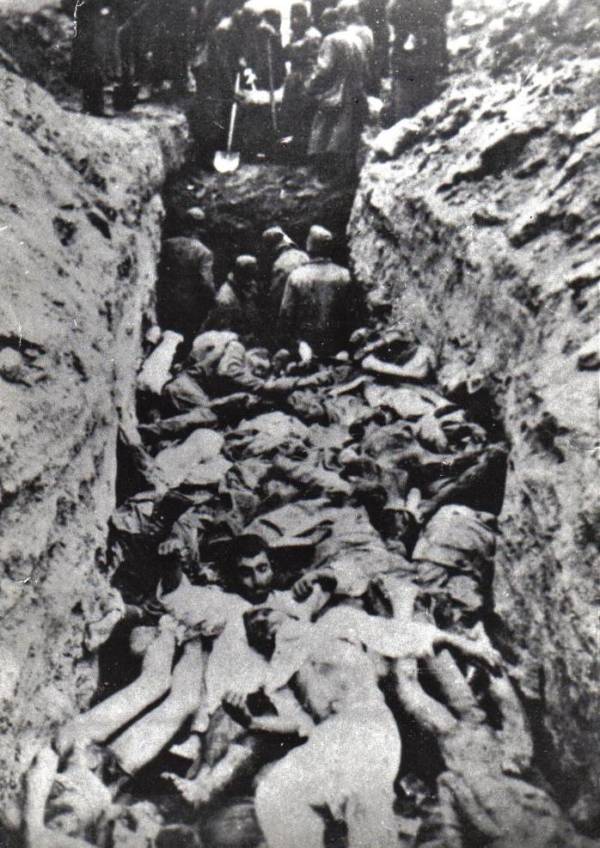 A mass grave outside of a ghetto, where people have been dragged out and shot.
A mass grave outside of a ghetto, where people have been dragged out and shot.
Lenin Zhitkovich, USSR. August 1942.
 The ruins of a ghetto.
The ruins of a ghetto.
Warsaw, Poland. April or May 1943.
 The dead bodies of executed Jews lie in the ruins of the Warsaw ghetto.
The dead bodies of executed Jews lie in the ruins of the Warsaw ghetto.
Warsaw, Poland. April or May 1943.

Warsaw, Poland. Circa 1940-1943.
Wikimedia Commons
 Captured Jews are marched off for deportation.
Captured Jews are marched off for deportation. Warsaw, Poland. April or May 1943.
Wikimedia Commons
 A cart full of clothes rolls through the Warsaw ghetto.
A cart full of clothes rolls through the Warsaw ghetto. Warsaw, Poland. Circa 1942-1943.
Wikimedia Commons
 Jewish rabbis are rounded up by SS officers.
Jewish rabbis are rounded up by SS officers. Warsaw, Poland. April or May 1943.
Wikimedia Commons

Jews sit and await deportation to the death camps. Warsaw, Poland.
April or May 1943.
Wikimedia Commons

A man comes out of hiding with his hands up.
Warsaw, Poland. April or May 1943.
Wikimedia Commons

The workers of a forced labor factory, where Jewish slaves were forced to make helmets for the Nazis, learn that they will not be spared. Warsaw, Poland. April or May 1943.
Wikimedia Commons

Nazis patrol the burning ghetto of Warsaw.
Warsaw, Poland. April or May 1943.
Wikimedia Commons

SS Officers enter Warsaw to shut down an uprising.
Warsaw, Poland. April or May 1943.
Wikimedia Commons

Polish families being deported into the Warsaw Ghetto.
Warsaw, Poland. Circa 1940-1942.
Wikimedia Commons

A Polish police officer checks the IDs of two Jewish men. Krakow, Poland.
Circa 1939-1945.
Wikimedia Commons

Jewish laborers work inside a sweatshop. Warsaw, Poland.
Circa 1942-1943.
Wikimedia Commons

Inside of a sweatshop in a Jewish ghetto. Warsaw, Poland.
Circa 1939-1945.
Wikimedia Commons

A Jewish doctor replaces his sign, on orders from the Nazis, to one written in Hebrew script and displaying the Star of David.
Krakow, Poland. May 1941.
Wikimedia Commons

A fish stall inside of the Warsaw ghetto, during the early days of the Holocaust. Warsaw, Poland.
May 1941.
Wikimedia Commons

The Nazis crack down on smuggling to keep food from getting into the ghettos. Krakow, Poland. May 1941.
Wikimedia Commons

Jews put into forced labor work on the railway.
Minsk, Belarus. February 1942.
Wikimedia Commons
 SS officers interrogate men inside the Warsaw ghetto.
SS officers interrogate men inside the Warsaw ghetto. Warsaw, Poland. April or May 1943.
Wikimedia Commons

A man is dragged out of hiding as the SS comes in to force the people of the Warsaw ghetto into the death camps.
Warsaw, Poland. April or May 1943.
Wikimedia Commons

Residents of the Warsaw ghetto sit on the curb, awaiting their fate.
Warsaw, Poland. April or May 1943.
Wikimedia Commons

The SS opens the underground bunkers where some have hidden to avoid being dragged out of the ghetto and into the death camps.
Warsaw, Poland. May 1943.
Wikimedia Commons

A family surrenders to the SS. Warsaw, Poland.
April or May 1943.
Wikimedia Commons

An SS lieutenant interrogates a man in the Warsaw ghetto. Warsaw, Poland.
May 1943.
Wikimedia Commons

Nazi soldiers discuss how best to evacuate and deport the Jewish workers inside of a factory.
Warsaw, Poland.
April 1943.
Wikimedia Commons

Men carry off a cart filled with the emaciated, starved corpses of children.
Warsaw, Poland. Circa 1941-1942.
Wikimedia Commons

A man covers his mouth with a handkerchief, struggling to breathe through the smoke. Warsaw, Poland. April or May 1943.
Wikimedia Commons

Jews captured during the Warsaw ghetto uprising are marched to a holding area for deportation.
Warsaw, Poland. April or May 1943.
Warsaw, Poland. April or May 1943.
Wikimedia Commons

Warsaw, Poland. April or May 1943.
Wikimedia Commons

Warsaw, Poland. April or May 1943.
Wikimedia Commons

Lenin Zhitkovich, USSR. August 1942.
Wikimedia Commons

Warsaw, Poland. April or May 1943.
Wikimedia Commons

Warsaw, Poland. April or May 1943.
Wikimedia Commons

Captured Jews are lead through the burning ghetto in Warsaw. They will be sent to the death camps.
Warsaw, Poland. April or May 1943.
Wikimedia Commons
like and Share...

No comments:
Post a Comment